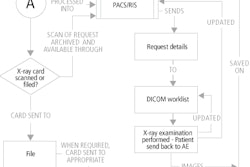Adopting electronic-signature capability can offer sharp reductions in radiology report turnaround times, according to an Online First article from the Society for Computer Applications in Radiology’s Journal of Digital Imaging.
"Electronic signature significantly shortens the time between transcription and finalization of radiology reports," wrote Dr. Luigi Lepanto from the University of Montreal Hospital (CHUM). "The RIS allows assessment of workflow by recording the timeline of status changes of imaging studies and can be used to evaluate the impact of interventions on the processes in a radiology department" (JDI online, December 15, 2003).
To analyze the impact of electronic signature, CHUM researchers queried the institution’s RIS database to locate all abdominal ultrasound and chest radiography examinations recorded within a one-month period. The study team looked at data from October 2001 (before implementation of electronic signature) and February 2002 (three months after adoption of electronic signature).
In October 2001, 466 abdominal ultrasound examinations and 1,651 chest radiographs were recorded in the RIS, compared with 402 abdominal ultrasound studies and 2,113 chest radiographs in February 2002. Each exam type had one reader per day, and a number of radiologists rotated through the sectors throughout the study periods.
The median time from transcription to final signature for abdominal ultrasound examinations declined from 11 days to three days following adoption of electronic signature. The proportion of finalized reports at three and seven days increased from 8.8% and 26.6%, respectively, in October 2001, to 44.8% and 61.4%, respectively in February 2002.
"With electronic signature, most reports are signed in the first two days, with a sharp drop-off thereafter," Lepanto wrote.
For chest radiographs, the median time from transcription to final signature dropped from 10 days to five days. The proportion of finalized reports at three and seven days after transcription increased from 7.7% and 40.8%, respectively, to 34.9% and 70.8% in February 2002.
Researchers also surveyed the radiologists to gauge their reaction to electronic signature. The survey asked:
- Do you perform your own corrections on screen?
- Do you consider electronic signature a positive addition?
- Does electronic signature improve the radiologists’ workflow?
All 42 of the radiologists surveyed answered the questions, and all of them claimed to perform their own corrections on-screen. All respondents said they believed electronic signature was a positive addition, with 80% believing it improved radiologists’ workflow.
Even speedier production of radiology reports can be achieved with speech recognition systems, but if such a system is not available, electronic signature can offer efficiency gains over a paper-based system, Lepanto said.
In addition to the economic factors associated with installing a speech recognition system, delays in introductions can also arise, since they have not attained the same level of sophistication in all languages, he said. And some studies have found that speech recognition can actually diminish radiologist productivity, Lepanto said.
"So although, ultimately, voice recognition systems will become the norm, at present electronic signature is an interesting alternative offering significant advantages," he said. "Also, electronic signature can represent an intermediate step before the introduction of voice recognition, allowing familiarization with on-screen editing for those radiologists still working in a paper-based system."
By Erik L. RidleyAuntMinnie.com staff writer
January 29, 2004
Related Reading
Electronic exam ordering offers pros, cons in PACS, January 6, 2004
Large-scale PACS initiatives require on-site DICOM testing, December 4, 2003
RIS-PACS integration delivers improved interpretation, reporting times, December 1, 2003
Workflow analysis can ease scheduling woes, November 28, 2003
High-volume teleradiology brings substantial benefits, September 19, 2003
Copyright © 2004 AuntMinnie.com



















